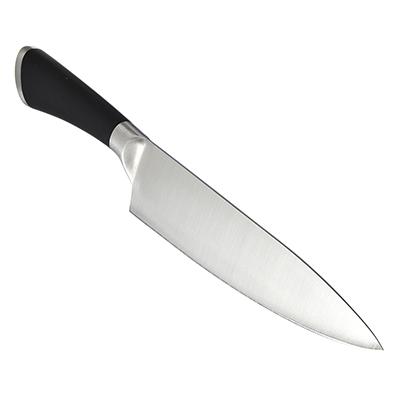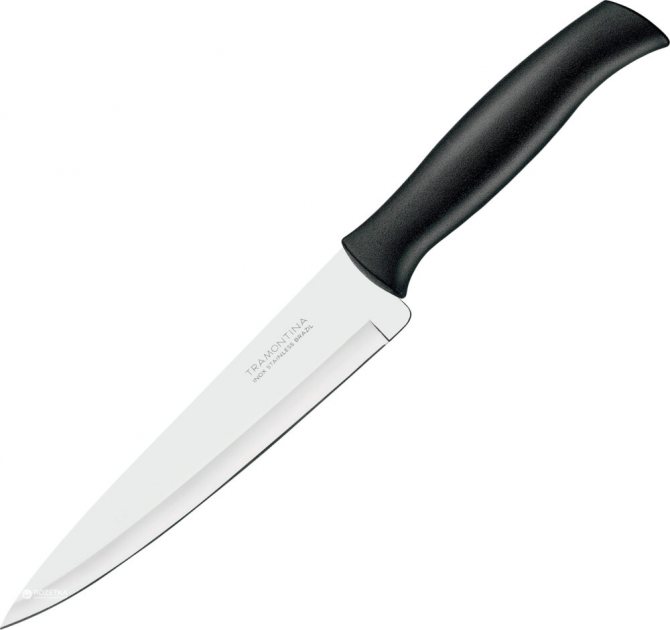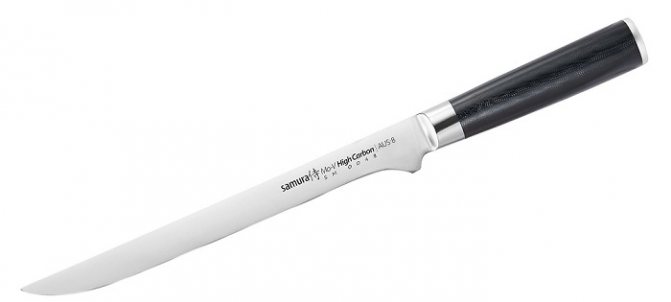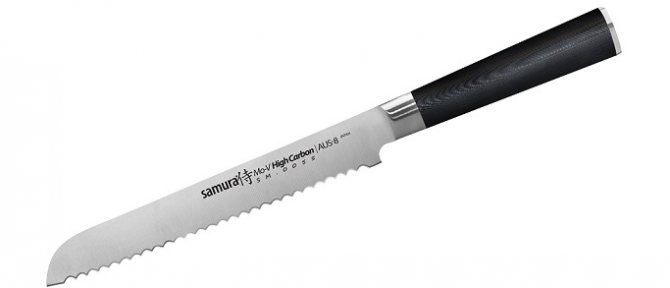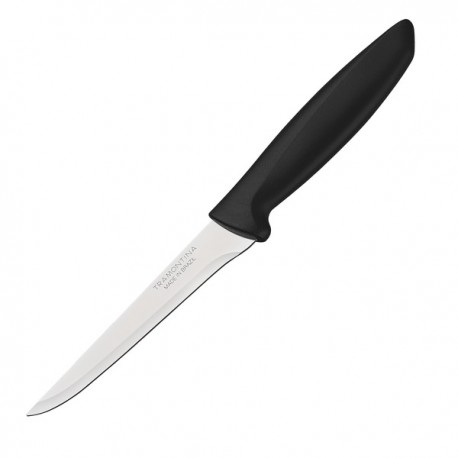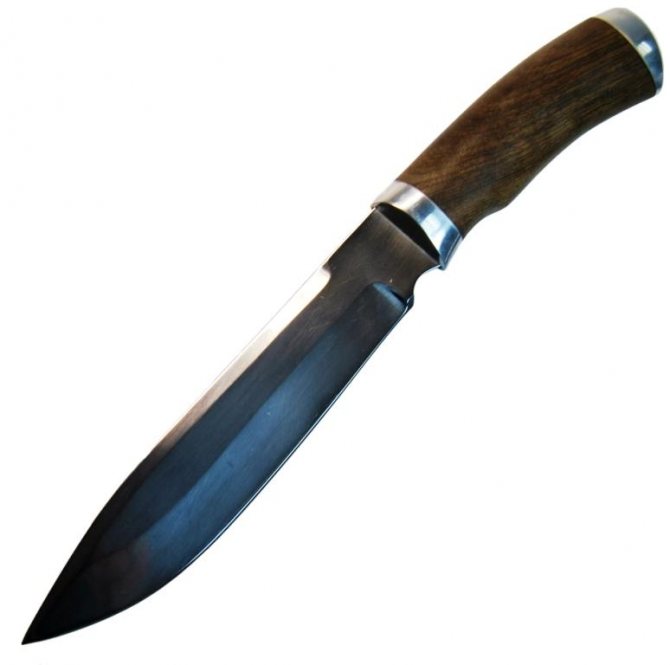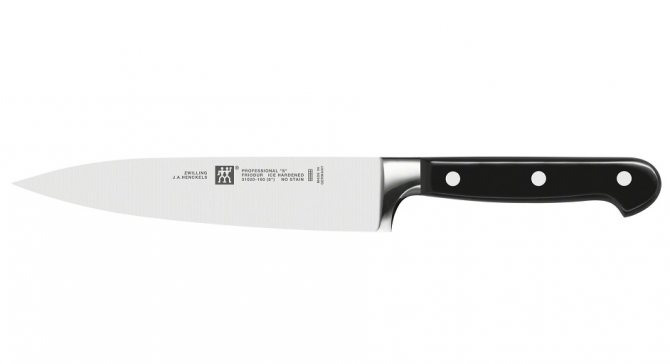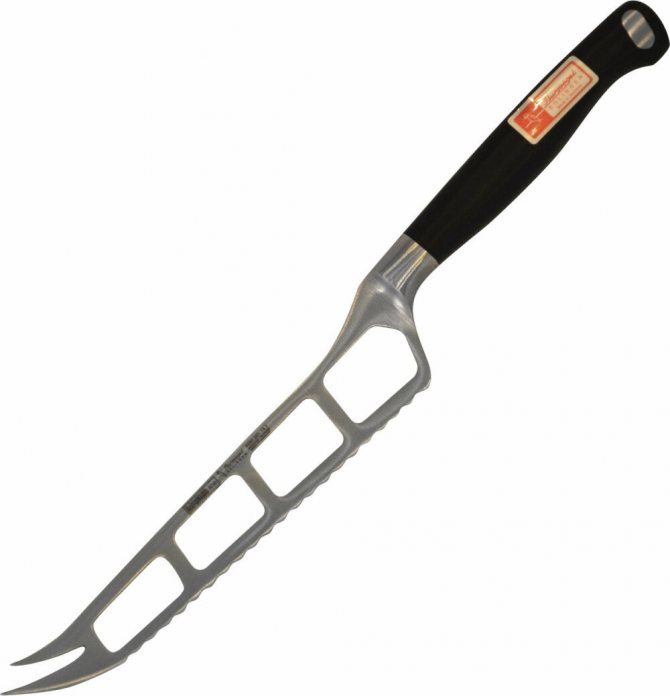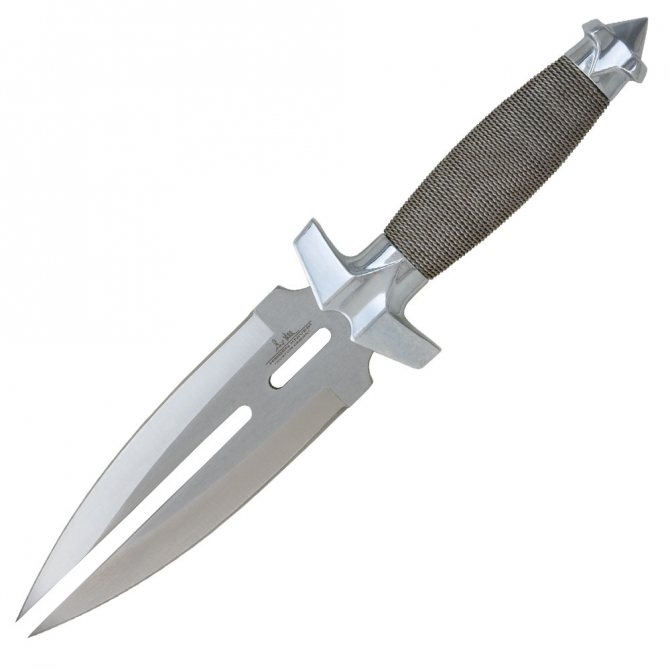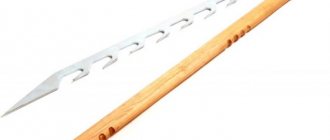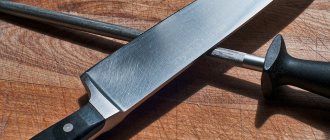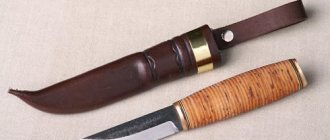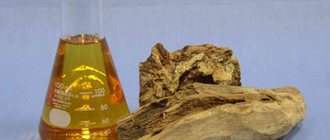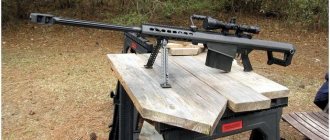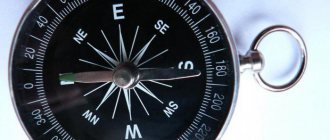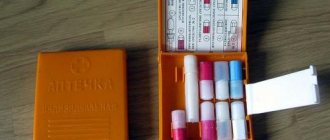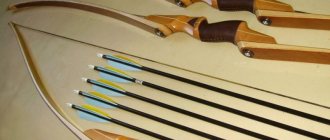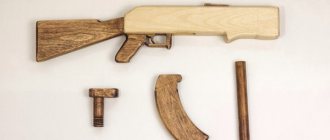The types of knives are varied - there are several types of kitchen knives, hunting knives, army knives, camping knives, which can be folding or fixed. For cooking there is a chef's, universal, bread, fillet, vegetable, cutting, and slicer. Hunters should use a short one with a wide blade. Tourists need to take a light one, with convex blade slopes. When choosing, it is important to pay attention to the material and parameters of the blade, and the comfort of the handle.
Main types of knives, their varieties and classification
The types of knives needed in many areas of human activity are determined by their purpose, shape, and the material from which the blades and handles are made. There are about 200 products in total. The classification also depends on the origin, because knives adopted, for example, in Japan differ from European ones. Taking into account all possible parameters, there are the following types:
| By origin | By purpose | Characteristics |
| European | Chef's or chef's knife | It has a blade size of 18-30 cm and can handle any type of kitchen work, except peeling vegetables. |
| Universal | The blade size is 15 cm, therefore it is intended for slicing vegetables, fruits, sausages, hard cheese, poultry meat | |
| For peeling vegetables | The length of the blade is 7-8 cm, it allows you to quickly peel vegetables and fruits | |
| Sirloin | They come with a blade of 10-15 cm for poultry, 15-34 cm for slicing pork, beef, lamb | |
| Bread | It has a serrated blade 20-25 cm long, cuts evenly the rough crust of bread, does not crush the delicate crumb | |
| Boning | Needed to separate meat from bones, therefore it has a blade length of up to 16 cm, the blade is narrow and thin | |
| Cutting | It has a wide, long blade made of the hardest possible material, therefore it is intended for cutting meat that contains bones and cartilage | |
| For slicing | The blade is quite wide, 25 cm long, so it is good to cut food into pieces of any size with a knife | |
| Japanese | Santoku | Similar to a chef’s knife for its intended purpose, but the blade length is up to 16-20 cm, width – 4-5 cm |
| Deba | Also with a wide blade, but the length varies from 13.5 to 27 cm, suitable for working with fish, poultry, meat without large bones | |
| Nakiri | The length of the working element is 16-18 cm, width – 5-6 cm, so it is convenient for them to cut herbs and vegetables | |
| Yanagi-ba | Has a narrow long blade (up to 47 cm), suitable for working with fish, including preparing sushi and sashimi | |
| Special kitchen | For slicing cheese, steaks, tomatoes, sandwiches, oysters, pizza, cleaning food cavities | Most have an unusual shape, come with notches, additional holes on the blade, and other features |
| Special | Army | They are considered melee weapons, intended for close combat and for use by military personnel in the field. |
| Hunting | Wide, retaining a sharp edge for a long time, often have a device for skinning animals | |
| Tourist | Lightweight and practical, easy to sharpen, can be used for various types of work while hiking | |
| Bivvy | Suitable for chopping and slicing fairly hard material | |
| Sports | They have a blunt edge and a sharp tip of the blade, as they are intended for throwing | |
| For professional use (medicine, diving, rescue work, gardening, etc.) | Vary greatly in shape and size |
A knife is primarily a cutting, sometimes piercing, instrument, the active part of which is the blade. It can be sharpened on one or both sides and have a thin point. Another important element is the handle.
And depending on how it is connected to the blade, knives are:
- folding;
- monolithic, in which the handle is made of the same material as the blade or another;
- ballistic, that is, the blade is separated from the handle and inserted into it.
History of appearance
The first known knives were created in the Paleolithic era, and were made of stone and shaped like an almond grain. Later, handles made of wood or animal bones began to be attached to them. The same materials, bamboo, were used to create the blade.
After the appearance of metal in the life of mankind, knives were made of copper and bronze, and in South America there were even products made of gold. Next came the iron ones. And as technological progress developed, knives began to be produced industrially, and not only their quality, but also a reduction in cost became important. During the same period, the first folding models appeared.
Kitchen knives, their sizes and purposes
Kitchen knives are one of the most diverse categories of products, there are dozens of types:
| Knife name | Description | Photo |
| Chef's or chef's knife | It has a blade length of 18-30 cm, thickness up to 2-3 mm, which is sharpened at an angle of 20 degrees. The blade of the product is triangular. Because of its size, it can be used to cut, slice, and shred meat, fruits, and vegetables. It is not entirely suitable only for bread. And when working in the kitchen for a long time, if the cook’s hands are small, they quickly get tired of him. |
|
| Universal | The dimensions of this type of product are 15 cm in length and 2.5-3.5 cm in width at the base of the blade. The shape is elongated, the knife itself is light and convenient. Hence the ability to do literally everything in the kitchen with it, except for cutting frozen meat or with bones. |
|
| Vegetable | The purpose of this type of product is to peel vegetables and fruits with hard skins. These are the smallest knives with a narrow blade up to 8 cm. And the sharp tip makes it easy to get rid of “eyes”, stains, and wormholes. |
|
| Sirloin | If its blade is up to 15 cm, the product is suitable for working with fish, poultry, and small pieces of meat that need to be cut. Knives with longer blades will help when cooking pork and beef. Blades are usually narrow, flexible, and have raised tips, so they should not be used for highly resistant products due to the risk of breaking. Sharpen the fillet knife at an angle of 15 degrees. |
|
| Bread | It is distinguished by a long, serrated blade with a uniform width throughout. Thanks to them, the hard crust and crumb lend themselves equally well to slicing. |
|
| Boning | It has a thin blade up to 16 cm long, which allows it to be used not only for separating meat from bones, but also for slicing small products. The blade is made of medium hard material. But because of this, as well as its small size, the knife is not used when working with frozen foods. |
|
| Cutting | This is a wide and long blade, hard material, so it is easy to cut meat, cutting cartilage and small bones. The blade is made of carbon steel, this is a more reliable option. But there are also ceramic cutting knives that need to be protected from falling and contact with bones. |
|
| For slicing | This knife is needed to turn a whole piece into slices, cubes, that is, smaller segments. It is distinguished by a wide blade up to 25 cm long, with a narrow sharp tip. |
|
Special types of knives are Japanese, and their purpose needs to be explained to Europeans:
- Santoku is distinguished by a wide (4-5 cm) and quite long (16-20 cm) blade, so it completely replaces a chef’s knife, and also chops vegetables and herbs, perfectly cuts meat, seafood, vegetables, even bread. There is a recess on the blade that prevents food from sticking to the surface. And the width allows you to use it as a spatula.
- The deba is similar to the santoku, but with a thinner blade edge. Its length is 13.5-27 cm. This knife can be used to work with fish, meat, and poultry if they do not have large bones.
- Nakiri is intended for vegetables and herbs, has a blade length of 16-18 cm, width - 5-6 cm. Its blade is often rectangular or with a rounded cutting edge, rather than pointed. They sharpen it at an angle of 4-6 degrees, sometimes on both sides.
- Yangi-ba is needed for thin slicing of fish fillets; thanks to the flexibility of the blade, it is used in preparing sushi and rolls. The product has a blade length of 27-40 cm, the main part itself is narrow.
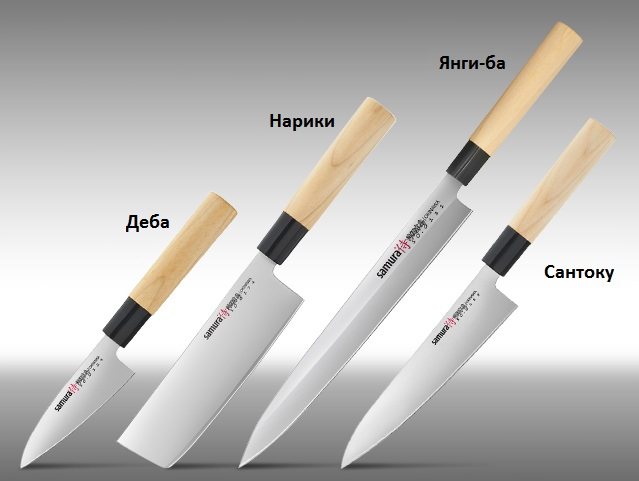
Japanese knives are distinguished by high quality steel, carbon or material with a hardness of 60 HRC. This makes them sharper, and remains so with prolonged use.
Knives that can be used in the kitchen:
- for cutting pizza in the form of a gear wheel with a handle;
- for cheese, with holes to prevent the product from sticking;
- for extracting contents from vegetables used for stuffing;
- with serrated sharpening for slicing tomatoes;
- for steaks, thinly slicing the flesh of meat;
- chop for quickly chopping greens or vegetables.

But each is only good for one job and can be replaced with more traditional knives.
Dining rooms
Table knives (usually up to 20 cm long, equal in size to the diameter of the corresponding plate) are used directly during the meal to make it convenient and aesthetically pleasing:
- fish with a wide blunt blade, it is convenient for separating fillets from bones;
- a snack bar with a rounded end, designed for cold and hot dishes of this category;
- dessert, thin, with a pointed tip, which is used when serving sweet dishes;
- fruity, similar to the previous device, but smaller in size;
- for steak, with a sharp, raised tip;
- for oil, having a wide arc-shaped blade;
- for cheese, sickle-shaped with teeth at the end.
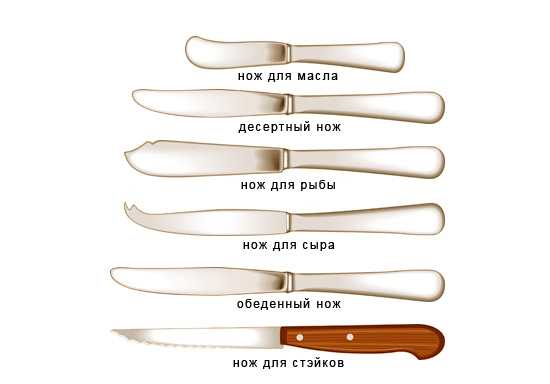
These utensils are used together with forks suitable for each dish.
Folding
Folding knives exist in the following types:
- mechanical, that is, opened manually;
- semi-automatic, when the blade needs to be pushed so that the mechanism further brings it to the desired position;
- automatic, opening when you press a button.
When folded, the blades of the products can be hidden on the side of the handle or in the front part, that is, according to the method of removing the blade, they are:
- vertical, which is simpler and therefore reduces the price of the knife;
- frontal, which require a complex mechanism.
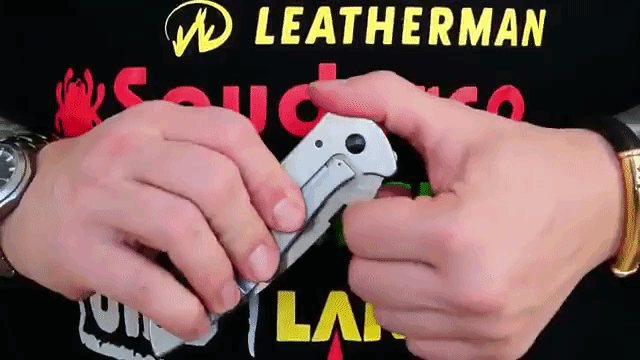
The device that holds the blade hidden in the handle is also important:
- spring for linear type of lock;
- a lever held by a spring hidden in the handle;
- a ring coupling that needs to be turned;
- movable pin;
- balisong lock.
Army, hunting, and tourist knives are made folding. In addition, they can also be multifunctional, that is, they contain not only a blade, but also a fork, spoon, scissors, etc.
Hunting
Hunting knives are different:
- handle made of wood, not plastic or metal;
- minimum size guard so as not to interfere with cutting the carcass;
- a blade made of Damascus steel or a hardness of at least 58 HRC, 10-14 cm long, 3 cm wide, butt 3-4 mm thick.
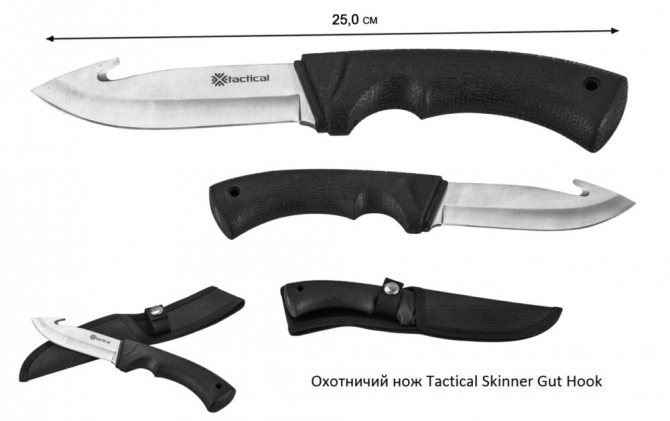
The best option is a skinner, which, in addition to all the advantages, has a hook for skinning.
Combat
A combat knife is always fixed, that is, not folding, durable and with a large guard and a sharp end of the blade. All this makes it possible to use it in close combat, dig in, cut metal barriers, etc.
These products are distinguished by:
- double-sided or one-and-a-half blade sharpening;
- oval shaped stalk;
- length 22-32 cm;
- the tip is on the same plane with the blade and handle;
- anti-reflective coating on the blade.
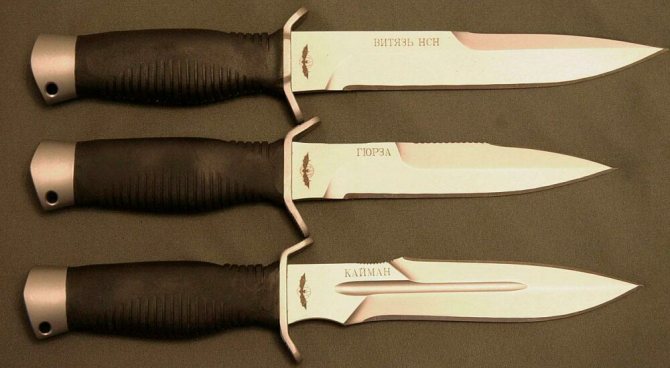
Special forces combat knives
For tourism
On a camping trip you should take a knife with the following parameters:
- fixed blade for safe use;
- wide lens-shaped blade or serrated sharpening for cutting branches, ropes, etc.;
- rounded tip to avoid injury when used on the go;
- smooth or slightly rough, but without cavities, handle for trouble-free washing (preferably made of plastic);
- steel, but with a low degree of hardness of the material for easy sharpening outside the home;
- stainless steel blade for long service life;
- sheath made of practical material, such as Kydex.
Watch the video on how to choose a knife for tourism:
Basic materials for production
The material of manufacture plays an important role when choosing a product. One of the most popular is wood. A wide variety of breeds are used. Thus, a light and practical handle can be obtained from dense maple, walnut, cherry and oak. Options made from tropical trees are reliable to use, but have a higher price.
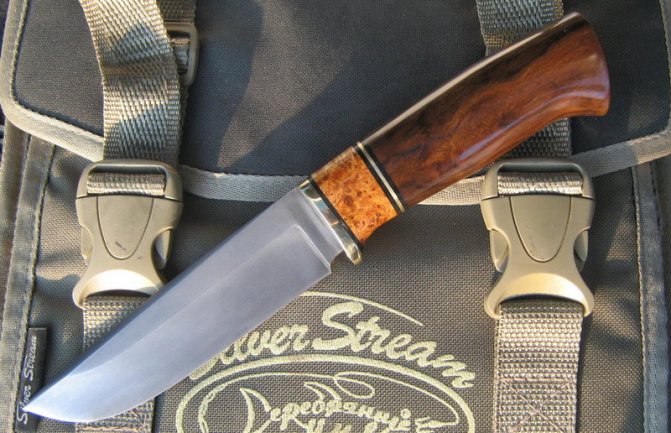
Other natural ingredients are also used to form the handles. Hunting knives are often decorated with the horns and skin of wild animals. The most common synthetic components are nylon, fiberglass, greyvari and carbon.
An excellent electrical insulating material is micarta - a polymer-type film with a resin base. Glued with fabric or paper with electrical insulating components. Micarta is distinguished by its pleasant appearance, moisture resistance, ease of processing and long service life.
One of the varieties of rubber, kraton, is used both as an insert and as the main element for the handle. It is characterized by high wear resistance and increased grip tenacity due to its anti-slip properties.
Less commonly used is G-10, a fiberglass laminate made from epoxy binders. The composition was originally developed for the production of circuit boards; today it has found application in handles. Advantages: high dielectric properties, moisture resistance, non-flammability, rich color range. A sharp decrease in temperature can lead to a decrease in the strength of the product.
Knife shapes, their names and characteristics
The shapes of kitchen and other knives are possible: curved, curved, square, cylindrical, cranked. The most interesting shapes of the blades, handles and names of the combat ones: navaja, bowie, bolo, karambit, kukri, kris. These are national types of bladed weapons.
Product characteristics depend on the purpose of use:
- wide and long blades can be found in bread knives, chef knives, universal knives, and chopping knives;
- army and hunting are usually short, but the former are quite narrow, and the latter - on the contrary;
- Tools for cleaning and small work are small.
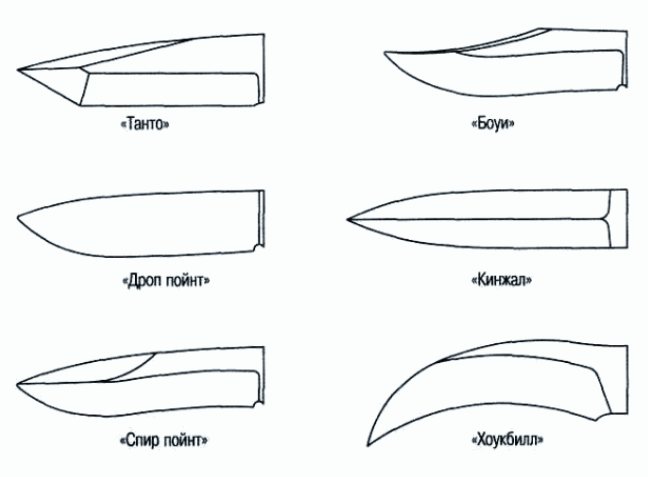
What knives are intended for is sometimes easy to understand by their dimensions. And, in addition, many kitchen appliances are interchangeable.
Curved
A curved knife is used:
- Hunters. This is a skinner that is convenient for cutting up a carcass and removing the skin.
- To do garden work. If you need copulation, that is, grafting one tree sprout onto another, a neat cut is required, and it is difficult to do with a standard tool.
- For peeling vegetables and cutting meat. These are two different knives, but the unusual blade shape helps you cope with both types of work faster.
- For stripping cables and wires. It is easier to remove the unnecessary shell with a device than with a straight blade.
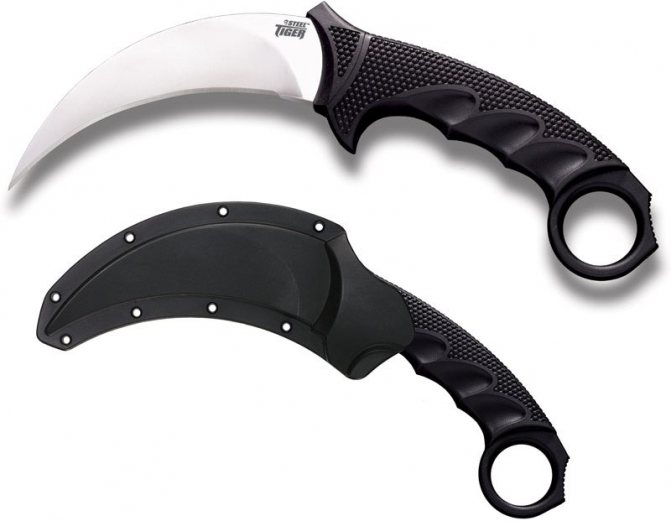
Curved knife Cold Steel Karambit Steel Tiger Fixed Blade Knife
Curves
Curved knives with a curved or wavy blade represent different countries and cultures:
- Spanish Navaja;
- American Bowie;
- Filipino bolo;
- Malay karambit;
- Nepalese kukri;
- Javanese kris.
All of them were used for combat purposes, and some were also used for agricultural work.
Nepalese kukri Javanese kris Malayan karambit Philippine bolo American bowie Spanish navaja
With wide blade
Tools with a wide blade are:
- santoku;
- cutting;
- cook or chef;
- deba;
- nakiri, which also has a square tip.
Each has its own purpose, but a skilled cook can do all the kitchen work with any of them, except perhaps peeling vegetables and fruits and cutting soft cheese. Both last operations are inconvenient to perform with such large tools.
Serrated
A tool with teeth can be used for working with fruits and vegetables. This knife is small. It is especially convenient for soft products such as tomatoes, as it does not crush the skin and pulp, but carefully cuts them.
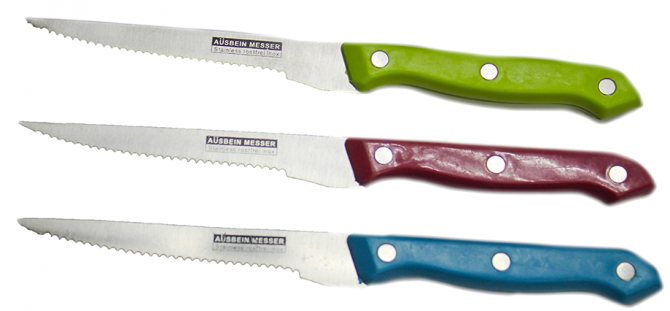
Sharp knife with a triangular bevel
A sharp kitchen knife with a triangular bevel is a fruit knife. It is necessary for cleaning fruits, but the blade is also convenient for cutting out beautiful figures or, if necessary, rotten spots from them. The size of this product is small; the blade is usually shorter than the handle.
A butcher knife, which belongs to the category of combat, can be described in the same words as fruit. But in the second, the blade is a blade with a longitudinal depression in the center, and the handle forms the letter T with it. The knife also has a triangular tip, but there is also a line of the butt that is curved upward.
Square
A square kitchen tool is a Japanese nakiri, used for slicing or finely chopping vegetables and herbs. It seems powerful, since it has a blade size of 16-18 s and a width of 5-6 cm. But the blade of the tool is thin and light, so cutting frozen meat with it, for example, is problematic.
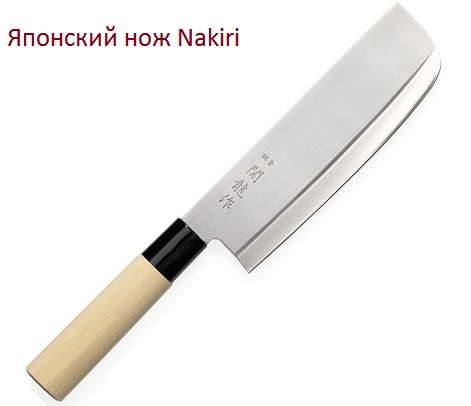
The nakiri should not be confused with a hatchet for chopping carcasses. It is made of thicker material, has a larger working part width and a raised edge of the butt.
Cylindrical
A cylindrical kitchen tool is essential for making cavities in food. It can be used when preparing stuffed peppers, when the middle of the vegetable is first removed. Or to prepare fruit for compote or jam. The knife allows you to maintain the shape of the product, but eliminates excess.
Cranked
When they say “cranked knife,” they mean a tool for slicing bread. It is quite long and has a wide blade, with serrations along the sharp edge. And the butt is rounded to the sharpened edge of the blade.
A decorating tool can also be called cranked. It has a rounded spine, and convex stripes are located perpendicularly along the sharp edge of the blade. These details give the surface of the slices a wavy appearance.
With a split blade
If the tool has a split blade, it may be:
| Knife name | Description | Photo |
| Cheese knife | It is distinguished by a blade with holes to prevent the product from sticking. And thanks to the fork-shaped tip, the slices can be immediately transferred to a plate. |
|
| Combat Double Shadow | Its blade is quite wide, 148 mm long. And the split takes up most of the working part of the bladed weapon. |
|
Long and short
Longest Kitchen Cutting Tools:
- chef's
- universal,
- bread,
- cutting,
- sirloin,
- boning
And from Japanese - yanagi-ba, a slicer for slicing.
The short ones are:
- vegetable,
- fruit,
- for steaks,
- sandwich
Short with wide blade
Short knives with a wide blade are practical for use outside the home, and some are effective for self-defense, so these are:
- army (fascinary for sapper work),
- hiking,
- combat (machete, cleaver);
- hunting
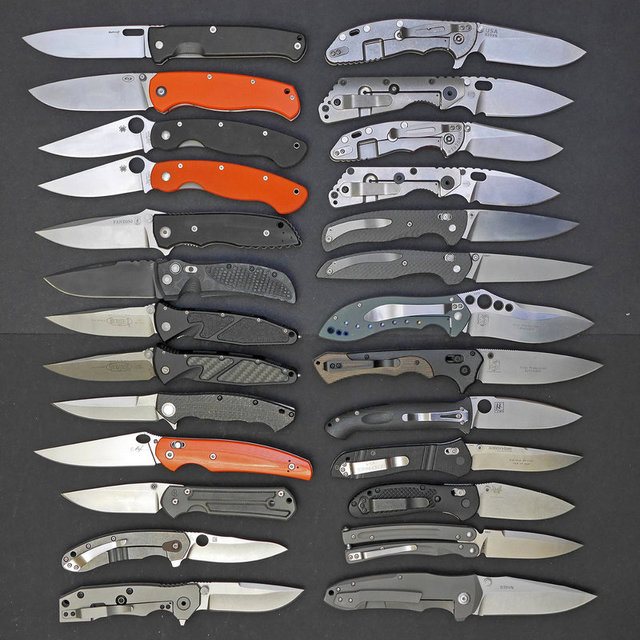
They can be easily hidden in a backpack or the pocket of a military uniform; they can be used to chop brushwood, cut a rope, whittle a stick, and even be used in a camp kitchen.
Examples of “correct” products
Now that you have a general idea of the design of the knife, you can start choosing it. So, let's talk about the types of knives (folding, cutting, hunting, throwing, fighting) and how to choose them correctly.
Hunting
There are many opinions on how to choose a good hunting knife. When hunting, you may need to finish off a wounded animal, sand it, and skin the carcass.
The first thing to remember when hunting is that we are not barbarians and it would be nice to keep some decency. Therefore, serrators and other elements that can cause additional suffering to the animal are not allowed on a hunting knife. For the same reason, the length of the blade of a hunting knife cannot be less than 14 cm.
- Daggers (pr. Cerberus, Kombat, Phoenix) have the best penetrating properties, so they are more “humane”. However, they are not very convenient for skinning and cutting up a carcass.
- The handle of the knife must be made of a material with good frictional properties and must be equipped with a guard.
An example of a good hunting knife would be the “Kolyma” Kizlyar. The Bowie-type blade with a well-defined rounded cutting edge has a length of 160 mm. The thickness of the butt is 4.7 mm. The triggers are concave, the handle is made of elastron, attachable, the assembly is threaded. The guard is metal, with a well-developed lower projection.
Having dealt with hunting knives, we will learn how to choose a product for tourism purposes.
Tourist
This knife has a wide range of uses. It should be convenient for them to carry out work on setting up a bivouac in the forest.
- The first requirement for it is to be durable so that, if necessary, it can act as a lever or replace an ax.
- The length is not too important, but it is better if the blade is at least ten centimeters. Thick butt, wedge-shaped slopes, handle with well-defined finger rests.
- It is better if the handle assembly is non-separable, since various works are necessarily accompanied by vibration, which weakens the threaded fasteners.
- Mounted handles made from solid wood are the worst choice, as they can fall apart if hit hard or dropped onto rocks.
- It’s a good idea to have a set of additional devices – a serrator, a choil, an additional cutting edge.
A good example of tourist knives are the models “Burbot” (Vityaz), “Field Tactic” (Master K) and “Strix” (Kizlyar).
- “Strix” is a clip point type blade 125 mm long with an additional RC (one and a half sharpening). The thickness of the butt is 3.8 mm. The handle is elastron, mounted, with a percussion spike on the pommel.
- “Burbot” is a normal blade 115 mm long, butt thickness 3.5 mm. The cutting edge has a wide curve, making it easy to sand with this knife. There is a notch on the butt for resting the toe, and on the lower edge of the heel there is a deep choil. The handle is elastron, with a percussion tang spike on the pommel.
- “Field Tactician” is a clip point type blade with a length of 143 mm. There is an additional RC, a recess for a finger on the butt and a choil. The thickness of the butt is 4 mm. The descents are straight. The handle is elastron, snap-on, secured with a hollow rivet. There is a striking spike on the pommel.
We will tell you below how and which ones to choose for cutting folding and non-folding knives.
What type of metal can a knife blade have?
To select a product, it is important to know the types of metal from which the knife blade is made, since the material comes in different strengths and manufacturing methods:
- high-carbon steel means that the blade is reliable, sharp, but susceptible to corrosion, difficult to sharpen with a standard whetstone, a special one is needed;
- Damascus is high strength, but lacks flexibility;
- Stainless steel is not afraid of corrosion, but quickly becomes dull;
- Ceramics cuts well, but breaks easily on hard surfaces; such a product should not be dropped.
High carbon steel knife Stainless steel knife Damascus steel knife Ceramic knife
Names of knife parts
The names of the components of the knife depend on its type:
- the blade is the main working part;
- handle or handle - what you hold with your hand when working with a tool;
- blade - a sharp edge located along the blade, in contact with the product or other shared surface;
- butt – the unsharpened side of the blade, opposite to the blade;
- the tip of the blade is its thinnest point;
- slopes - planes tapering from the butt to the blade;
- the head of the handle is the part of the handle farthest from the tip;
- the heel of the blade is its blunt part adjacent to the handle;
- fullers - indentations on the blade along the butt (they are found mainly on military or military weapons, hunting knives);
- crosspiece, also known as crosshair or guard - the part located between the blade and the handle (also typical for army and combat knives);
- serrated – the line where the teeth are located on knives for cutting bread and soft fruits (this is usually not the case on others).
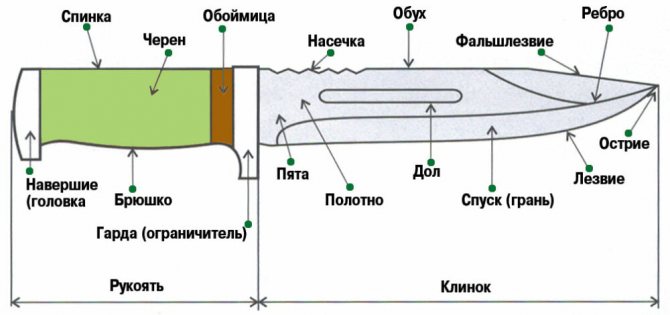
The design of modern combat knives
In recent years, so-called tactical knives have become increasingly popular among sellers and consumers. Many experts in the field of old-school edged weapons believe that this term is not entirely correct. A tactical knife is a weapon that can be used not only as a combat weapon, but also to perform household or household tasks.
Today, one of the trends in the development of combat knives has been the introduction into their design of the most successful technical solutions taken from the so-called survival knives. Another noticeable trend is the maximum simplification of knife design. In addition, a modern combat knife must be adapted to various conditions of use and be versatile. That is, to perform not only combat functions, but also to be suitable for various tactical actions, without which it is difficult for a fighter to do in combat conditions.
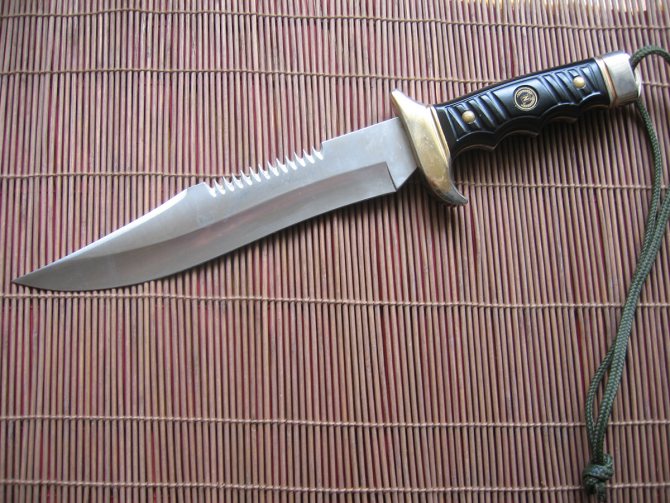
A combat knife must be able to quickly cut a cable or wire, remove branches or other obstacles, deal with a lock, dig a shelter, or open a can of canned food.
Before we talk about the most popular Russian and foreign combat knives, a few words should be said about the design of knives and the terminology that is used to describe them. And also about the most common blade shapes and methods of sharpening them.
Any knife consists of two parts: a blade (1) and a handle (2). The blade ends with a tip (3), and the handle ends with a pommel (10). At the bottom of the blade there is a blade or cutting edge (4). On the side of the blade opposite to the blade there is a butt (6). A bevel, descent or grind is a surface that tapers towards the blade blade (5). Such a surface is called a false bevel if it does not end with a blade (for example, on the butt). It is designed to lighten the blade. For the same purpose, small grooves are made on the side surfaces of the blade - valleys (7). In addition, they improve the balance of the knife by moving its center of gravity closer to the handle.
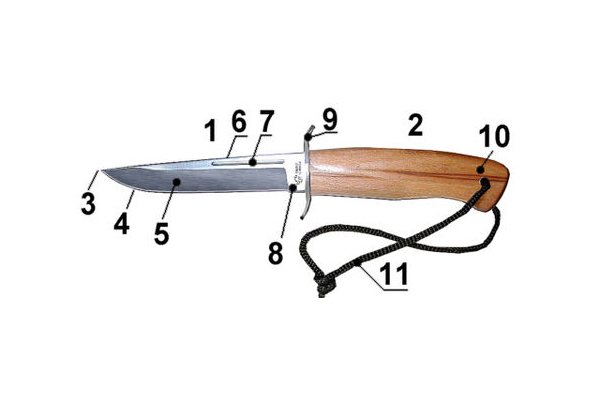
Both fullers and false bevels are not very necessary for small and medium-sized knives; often the manufacturer makes them for aesthetic reasons.
The unsharpened part of the blade, located directly next to the handle, is called the heel of the blade (8). In this part the blade resembles an ordinary metal rectangle. The main part of the handle, by which the knife is held, is indicated by the handle; between it and the blade there is a cross (9), it is often (and incorrectly) called the guard. Previously, the guard served not only to protect the hand in a duel, but with its help it was possible to block the enemy’s weapon. However, today, even if a knife has a guard, it is of a decorative nature.
The part of the blade inside the handle is called the tang. There are several types of attachment of the handle to the shank. The back of the handle is called the pommel or head. Sometimes a hole is made in the head and a lanyard is inserted into it.
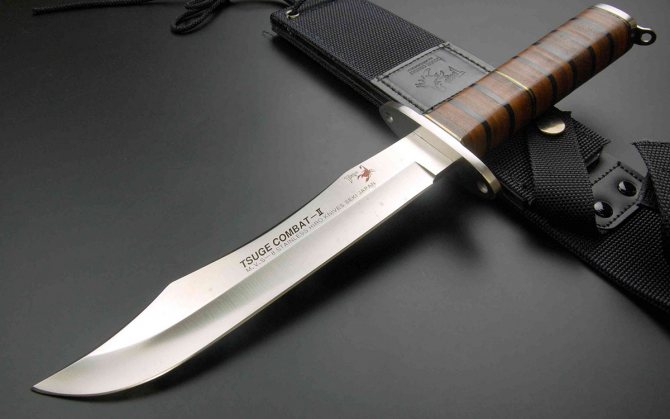
Blades: what they look like, their shapes
The blade of the knife looks as the purpose of the product dictates:
- wide ones are needed to separate hard and bulky material (meat, bones, tree branches, etc.) into parts;
- narrow - for thinly slicing food or hitting an enemy with one blow;
- long ones can be both wide and narrow; they are necessary where you need to work quickly with large material;
- short ones also differ in width, and they are needed for smaller work, as well as the ability to carry the product with you.
The forms of the main part of the knife are:
- with a straight spine and a rounded blade, a sharp end;
- with a lowered butt line and also a rounded, sharpened part;
- with a rising line of a blunt edge and a sharp, upturned tip;
- with a beveled spine and a rounded blade;
- with a straight blade and a rounded blunt side;
- with a butt longer than the blade, connected by a straight line;
- with a pike-shaped tip and sharpened edges on both sides of the blade.
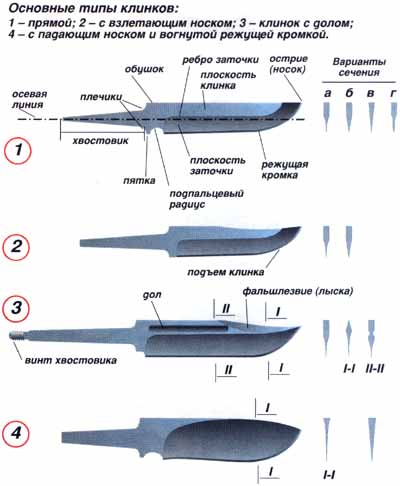
Typical sharpening shapes
Wedge sharpening. A classic sharpening shape that is well suited for blades that experience significant stress. Such a knife can be used not only as a weapon, but also as a tool. The blade from the blade evenly thickens upward.
Dove sharpening. It is made in the form of a narrow and very thin blade that cuts perfectly and is highly sharp. This kind of sharpening is also called razor sharpening. However, there is also a negative side to this: such a blade is less durable than with a wedge sharpening. Typically, such knives have a massive spine, which ensures the strength of the blade. Knives with wedge-shaped sharpening are intended exclusively for cutting; using them as a tool is extremely problematic.
Sharpening in the form of a chisel. A similar sharpening is used in Japanese kitchen knives, and it is a single-sided wedge-shaped sharpening. There is controversy as to which side it is better to do it on, the right or left. When working, it is necessary that the sharpened side is on top. This is exactly how a carpenter works with a chisel. It turns out that such knives need to be made separately for left-handers and for those who are better with their right hand.
Convex sharpening. This type of sharpening is rarely used for combat knives; it is most often used when sharpening axes. Knives that use a convex sharpening are most often used as cleavers.
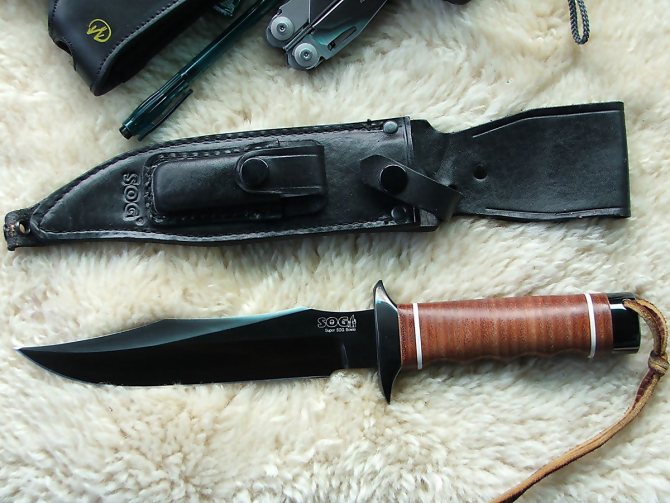
Types of knife descents
There are different types of triggers on different types of knives:
- Flat. Make the blade triangular, suitable for cutting.
- Straight. With them, the tip of the blade is a more obtuse angle than in the previous case.
- Concave. This type of cutting edge is very sharp, and the butt is powerful and durable.
- Convex. Such descents make the entire blade invulnerable when cutting.
- Straight with leads to the cutting edge. Most European knives have such slopes; they are similar to the first type from the list, but the cutting edge is formed by a more obtuse angle.
Rules of operation and care
When using any type of knife, it is recommended to follow the rules of operation and care; this is important to increase service life and maintain appearance:
- The knife should only be handled with dry hands, this helps to avoid injury.
- After each use, the instrument is washed and wiped dry. It is better to wash cutlery by hand; many knives do not tolerate the dishwasher well.
- It is not recommended to store knives in a tray with other cutlery. To do this, purchase magnetic strips or special wooden stands.
- It is important to sharpen your knife on time. To do this, use steel or stone sharpening, as well as diamond-coated devices.
Rules and selection criteria
You should choose a tool taking into account:
- What will it be used for ? In the kitchen you need no more than 3 knives: a large one for cutting poultry and meat, a long one for slicing food, a small one for peeling vegetables. The chef's one can be replaced with a universal one, especially with small hands. But you won’t be able to comfortably use a hunting one for peeling potatoes, although it is also small.
- Blade material . For example, ceramics are not suitable for meat, poultry and fish, as they may break if they hit a bone. It is also inconvenient to cut cheese with such a knife; it sticks.
- Pen . It should be comfortable, not slip, not twist. It is best to use impregnated wood or another material with a rough surface.
- Functionality . If the knife is folding, it should be easy to open with one hand. And a high-quality fixed one is removed from its sheath without delay.

The best manufacturers
The most popular companies making knives for the home:
- Samura. Metal products from large to small, made of high-quality steel with excellent sharpening. Prices – from 1000 rub. up to 4000 rub. a piece.
- Tramontina. There are ceramic tools, metal ones, several series, different types of blades, including special ones (hunting, camping). Cost – from 300 rub.
- Supra. Also presents series made of steel and ceramics. Prices – from 500 rub. up to 5000 rub.
- Gipfel. The knives are metal, with comfortable handles; there are some that are not found in other companies. Cost – 900-4500 rub.
